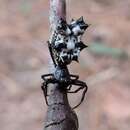en
names in breadcrumbs


Female Micrathena gracilis are easily recognized by their bulky, striped or mottled abdomen adorned with five pairs of black-tipped spines. They are usually about 1 cm long. This species is sexually dimorphic. Males are much smaller than females, and their abdomen is long and flat and lacks prominent spines.
The Spined Micrathena lives in dense deciduous forests in eastern North America and Central America. Females construct a web in large open spaces in the understory. The web is two-dimensional with a sticky, densely woven spiral (Uetz & Hartsock 1987). It is used to trap flying insects. Flies (Diptera) are the most common prey (Uetz 1990, Uetz & Harstock 1987).
Mature males do not build webs (Bukowski & Christenson 1997, Hodge 1987). They visit females in their webs to mate. Sexual cannibalism appears to be rare in this species and has been observed only when two males courted a female simultaneously (Bukowski & Christenson 2000)
Micrathena gracilis is a spider in the family Araneidae (orb-weavers),[1] commonly known as the spined micrathena[2] or castleback orbweaver.[3] This spider spins a moderately large (can be about 20 cm long in diameter) and very tightly coiled web. The spiders themselves are small and can be found to be anywhere from 4.2 mm to 10.8 mm long.[4] Its venom is harmless to humans. M. gracilis is unique in appearance due to its large spiky abdomen and black and white bodies. Certain spiders of this species can also display a yellow color on the sides of their bodies.[5] These spiders can be seen most active during the end of the summer and beginning of fall. M. gracilis is diurnal and are rarely ever seen active at night.[6]
Females are 8–10 mm long. They exhibit a bulbous abdomen with spines. Males exhibit a fair amount of sexual dimorphism. They tend to be a fraction of the size of the females. Also, they have fewer spines, a flatter abdomen, and a slightly lighter tone. Although males can produce silk, they mostly use it in the mating ritual.
When constructing webs, the inner orbs of their webs are changed every night; however, they may keep the outer layer of the web the same for multiple days.[6]
Micrathena gracilis is native to North and Central America.[1] These spiders tend to wander and rarely ever remain in the same web site for more than week. On average, they spend about 6–7 days on each web site. They are neotropical forest spiders and can be found more easily in hardwood forests that contain Oak and Hickory trees. They tend to like moisture; they are more easily found in woodland forests that are near a lagoon, pond, or other small bodies of water. One study mentioned that these spiders were found in an area that tends to flood during their mating season.[7] M. gracilis may also coexist within and along the edges of colonies of Metepeira incrassata, also known as the colonial orb-weaving spider.[8] They prey on the skimming bluet and are in turn eaten by white-eyed vireos.[2]
Micrathena gracilis hatches in the spring, the image of an adult. After the summer's growth, the female lays eggs in a sac. These remain relatively dormant through the winter months. The general life span is one year in length.
Micrathena gracilis is a spider in the family Araneidae (orb-weavers), commonly known as the spined micrathena or castleback orbweaver. This spider spins a moderately large (can be about 20 cm long in diameter) and very tightly coiled web. The spiders themselves are small and can be found to be anywhere from 4.2 mm to 10.8 mm long. Its venom is harmless to humans. M. gracilis is unique in appearance due to its large spiky abdomen and black and white bodies. Certain spiders of this species can also display a yellow color on the sides of their bodies. These spiders can be seen most active during the end of the summer and beginning of fall. M. gracilis is diurnal and are rarely ever seen active at night.